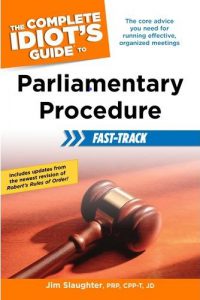
Complete Idiots Guide to Parliamentary Procedure
This question was asked elsewhere online, and my answer may be of interest to others–
Unfortunately, without more facts the answer is likely “it depends.” If your adopted parliamentary authority is Robert’s Rules of Order Newly Revised (11th Edition) (“RONR”), there are several competing considerations:
(1) RONR § 47 (p. 449) provides that the presiding officer has an obligation “to state and to put all questions that legitimately come before the assembly as motions . . . .”
(2) However, RONR § 47 (p. 450) provides that the presiding officer should “protect the assembly from obviously dilatory motions by refusing to recognize them.”
(3) RONR § 62 (p. 650) was significantly expanded in the latest edition and is entitled “Removal from Office and Other Remedies for Dereliction of Duty in Office or Misconduct.” That section notes, “If the chair at a meeting acts improperly (for example, fails to recognize a member entitled to the floor, see 42, or ignores a motion properly made and seconded that is not dilatory, see 39, and neither states the question on the motion nor rules it out of order), a Point of Order (23) may be raised, and from the chair’s decision an Appeal (24) may be taken.”
Taken together, there are several possibilities to your question. If the motion to close debate is being yelled out (not properly made by someone who was recognized and given the floor) by someone who has repeatedly violated the rules, the chair could rule the motion out of order and refuse to recognize it. However, if the motion was properly made and seconded, the chair should process the motion and let the body decide it (after all, it will only take about 10 seconds since the motion is undebatable and requires a 2/3’s vote). If the chair ignore a motion/seconded in good faith, options for members include a Point of Order for the chair to rule on, an Appeal for the body to decide the question, or even possibly processing the motion from the floor themselves (see § 62).
At the end of the day, the body decides all procedural questions, which reinforces the idea that the chair is the servant of the assembly, not the master of the assembly.
In case they are of interest, I’ll note that these processes are more fully described in my two books on Robert’s Rules of Order.
The Complete Idiot’s Guide to Parliamentary Procedure Fast-Track is a quick go-to guide and provides details on the most used motions, appropriate informal procedures for smaller boards, and general advice for shortening meetings.
Notes and Comments on Robert’s Rules, Fourth Edition is a user’s guide to the new 716 page edition of Robert’s Rules of Order Newly Revised (11th Edition) and uses a question-and-answer format to cover the most misused and asked-about provisions, including those that apply to larger membership meetings. Notes and Comments received the 2013 Phifer Award from the National Communication Association.
There are also many free charts and articles on Robert’s and meeting procedure at my Website, www.jimslaughter.com. All of the information on the Website is free, so feel free to use or share.

